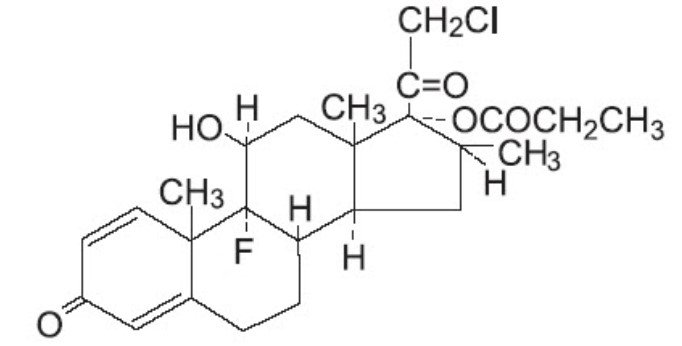Clobetair
Generic name: clobetasol propionate
Dosage form: cream
On This Page
Rx only
FOR TOPICAL DERMATOLOGIC USE ONLY - NOT FOR OPHTHALMIC, ORAL, OR INTRAVAGINAL USE.
Clobetair Description
Clobetasol Propionate Cream USP, 0.05% contains the active compound clobetasol propionate, a synthetic corticosteroid, for topical dermatologic use. Clobetasol, an analog of prednisolone, has a high degree of glucocorticoid activity and a slight degree of mineralocorticoid activity.
Chemically, clobetasol propionate is (11ß,16ß)-21-chloro-9- fluoro-11-hydroxy-16-methyl-17-(1-oxopropoxy)-pregna-1,4- diene-3,20-dione, and it has the following structural formula:

Clobetasol propionate has the molecular formula C25H32CIFO5 and a molecular weight of 467. It is a white to cream-colored crystalline powder insoluble in water.
Clobetasol propionate cream contains clobetasol propionate 0.5 mg/g in a cream base composed of cetyl alcohol, citric acid, glycol stearate, lanolin oil, methylparaben, PEG-8 stearate, polysorbate 60, propylene glycol, propylparaben, purified water, sodium citrate, stearyl alcohol, and white petrolatum. Sodium hydroxide may be used to adjust pH.
Clobetair - Clinical Pharmacology
Like other topical corticosteroids, clobetasol propionate has anti-inflammatory, antipruritic, and vasoconstrictive properties. The mechanism of the anti-inflammatory activity of the topical steroids, in general, is unclear. However, corticosteroids are thought to act by the induction of phospholipase A2 inhibitory proteins, collectively called lipocortins. It is postulated that these proteins control the biosynthesis of potent mediators of inflammation such as prostaglandins and leukotrienes by inhibiting the release of their common precursor, arachidonic acid. Arachidonic acid is released from membrane phospholipids by phospholipase A2.
Pharmacokinetics
The extent of percutaneous absorption of topical corticosteroids is determined by many factors, including the vehicle and the integrity of the epidermal barrier. Occlusive dressing with hydrocortisone for up to 24 hours has not been demonstrated to increase penetration; however, occlusion of hydrocortisone for 96 hours markedly enhances penetration. Topical corticosteroids can be absorbed from normal intact skin. Inflammation and/or other disease processes in the skin may i...



